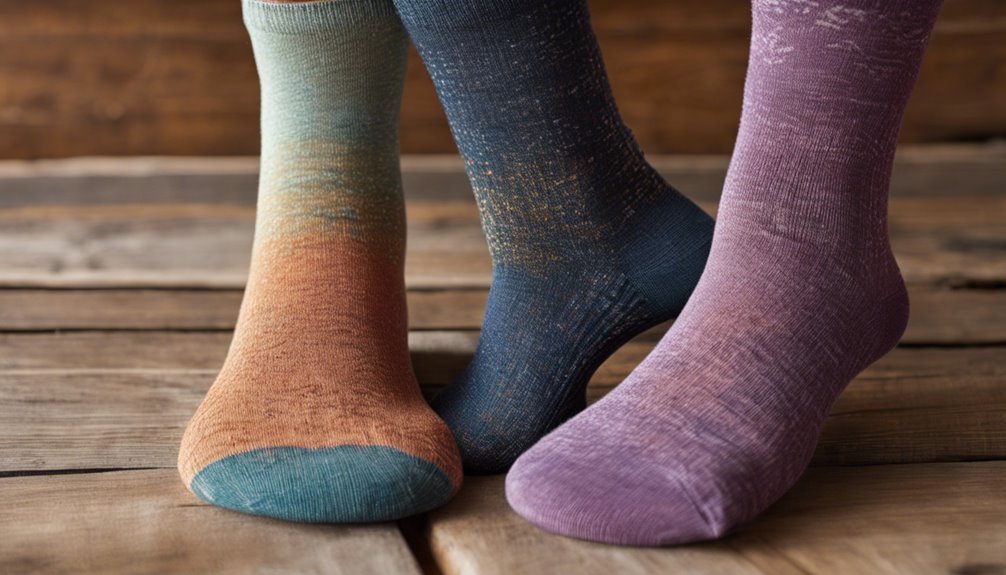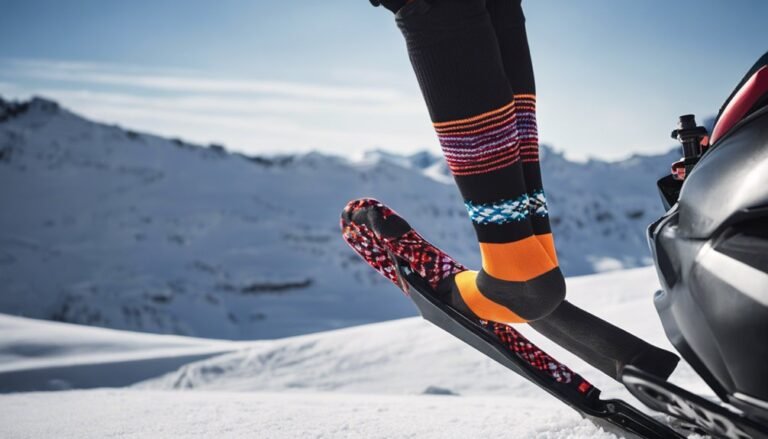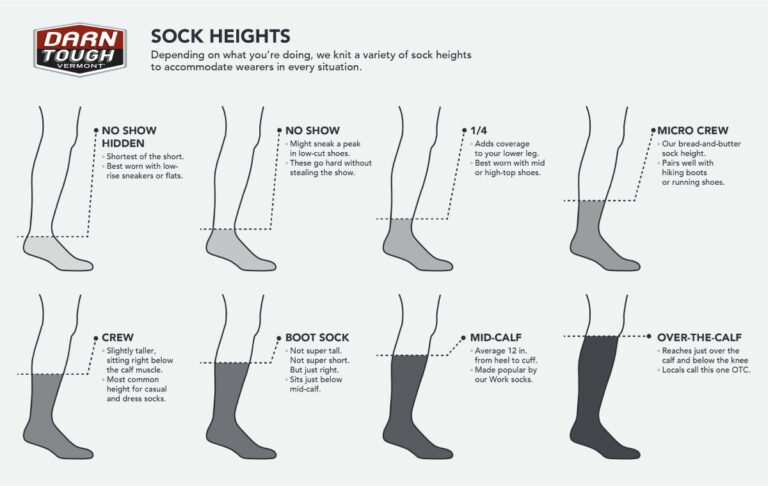Moisture-Wicking Socks vs. Cotton Socks: Which Is Best for Summer?
When it comes to summer, moisture-wicking socks come out on top. They actively manage moisture, keeping your feet dry and cool during activities like hiking or running. Unlike cotton socks, which can trap heat and moisture, moisture-wicking options provide a snug fit that reduces blisters and discomfort. Plus, they're more durable and quick-drying. If you're looking to enhance your comfort and performance, you'll want to explore the specific benefits that cater to your needs.
Understanding Moisture-Wicking Socks

When you're choosing socks for physical activities or everyday wear, understanding moisture-wicking socks can make a significant difference in comfort and performance. These specialized socks are designed with advanced sock materials that effectively manage moisture, drawing sweat away from your skin and allowing it to evaporate. This helps keep your feet dry, reducing the risk of blisters and discomfort during prolonged activity. Typically made from synthetic fibers, like polyester or nylon, moisture-wicking socks offer superior breathability compared to traditional cotton. By prioritizing moisture management, you can enhance your overall experience, whether you're running, hiking, or just enjoying a casual day out. Embracing moisture-wicking technology can empower you to move freely without the distraction of soggy socks.
The Benefits of Cotton Socks
When it comes to comfort, cotton socks excel with their breathability and softness, making them a favorite for everyday wear. The natural fibers in cotton not only feel great against your skin but also allow for better airflow, keeping your feet cool. Plus, they're generally hypoallergenic, which means you can enjoy that comfort without worrying about irritation.
Breathability and Comfort
Although moisture-wicking materials have gained popularity in recent years, cotton socks still offer a level of breathability and comfort that many find unmatched. When you're engaging in summer activities, you want breathable materials that let your feet relax while keeping you cool. Cotton provides excellent airflow, helping regulate temperature without trapping heat.
| Feature | Cotton Socks | Moisture-Wicking Socks |
|---|---|---|
| Breathability | High | Moderate |
| Comfort | Soft and plush | Firm and snug |
| Durability | Moderate | High |
| Moisture Control | Low | High |
| Ideal Use | Casual wear | Athletic performance |
With cotton, you can enjoy a soft, comfortable experience, making it a solid choice for those hot summer days.
Natural Fiber Advantages
While many opt for synthetic materials in athletic wear, cotton socks offer distinct advantages that make them a compelling choice for everyday comfort. First and foremost, cotton is a natural fiber, which means it's breathable and gentle on your skin, reducing the risk of irritation. You'll appreciate the softness, especially on hot summer days. Additionally, cotton is biodegradable, providing significant sustainability benefits compared to synthetic options that contribute to environmental waste. When you choose cotton socks, you're not just prioritizing comfort; you're also making an eco-friendly choice. Plus, cotton's moisture-wicking properties, while not as advanced as synthetic materials, still help keep your feet feeling fresh. Enjoy the freedom of movement and the peace of mind that comes with wearing natural fibers!
Comfort and Fit: A Comparison
Choosing the right socks can greatly impact your overall comfort during physical activities. When it comes to fit preferences, moisture-wicking socks generally offer a snugger fit, designed to mold to your feet for enhanced support. This can reduce friction, minimizing blisters and discomfort. On the other hand, cotton socks tend to have a looser fit, which some may find comfortable, but they can bunch up and create pressure points during long wear. Additionally, sock styles vary widely; you can choose from ankle, crew, or knee-high options. Each style impacts how well the sock hugs your foot. Ultimately, considering your personal fit preferences and choosing the appropriate sock style can enhance your summer activities, keeping you feeling free and comfortable.
Performance in Hot Weather
When the temperature rises, the type of socks you choose can greatly impact your comfort and performance. Moisture-wicking socks excel in heat regulation and moisture absorption, keeping your feet cooler and drier during intense activities. In contrast, cotton socks can trap heat and moisture, leaving you feeling uncomfortable in hot weather.
Heat Regulation Capabilities
As temperatures rise, the choice between moisture-wicking socks and cotton socks becomes vital for maintaining comfort and performance. Moisture-wicking socks are specifically designed to enhance sweat evaporation, pulling moisture away from your skin to keep your feet dry. This active moisture management reduces heat retention, which is important during hot weather, as it helps regulate your body temperature. On the other hand, cotton socks tend to absorb moisture, leading to a damp environment that traps heat and can leave your feet feeling uncomfortable. For those who crave freedom and seek to enjoy summer activities without the burden of sweaty feet, moisture-wicking socks are the clear winner, promoting ideal airflow and cooling during those scorching days.
Moisture Absorption Efficiency
While you might appreciate the softness of cotton socks, their moisture absorption efficiency in hot weather can be a significant drawback. Cotton tends to retain moisture, leading to discomfort and increased sweat. In contrast, moisture-wicking socks excel in moisture management and sweat prevention, keeping your feet dry and cool.
| Sock Type | Moisture Absorption | Drying Time |
|---|---|---|
| Cotton Socks | High | Slow |
| Moisture-Wicking Socks | Low | Fast |
| Performance Rating | Moderate | High |
Choosing the right sock can enhance your summer experience. Opt for moisture-wicking options to enjoy your activities without the distraction of soggy, uncomfortable feet. Your feet deserve the freedom to breathe!
Comfort During Activities
Choosing the right socks can greatly impact your comfort during activities, especially in hot weather. Moisture-wicking socks excel in temperature control, actively pulling sweat away from your skin to keep your feet cool and dry. This feature enhances your overall comfort, allowing you to focus on your performance without distractions.
In contrast, cotton socks absorb moisture but can leave you feeling clammy, increasing the risk of blisters. If you're engaging in activities like hiking or running, investing in moisture-wicking socks also provides better ankle support, helping to stabilize your feet during movement. With the right socks, you can enjoy your summer adventures while keeping your feet comfortable, dry, and ready for whatever the day brings.
Durability and Care

When it comes to durability and care, moisture-wicking socks often outshine their cotton counterparts. In a durability comparison, moisture-wicking materials are engineered to withstand rigorous activities and frequent washing without losing their shape or effectiveness. Cotton socks, while soft, tend to wear out quicker and lose elasticity, especially when damp. For care instructions, moisture-wicking socks are typically machine washable and quick-drying, making them easy to maintain. You can toss them in the washer without worry, whereas cotton requires more delicate handling to avoid shrinking. Choosing moisture-wicking socks not only guarantees longevity but also lessens the hassle of upkeep, giving you the freedom to focus on enjoying your summer activities without the burden of constant replacements.
Price and Value
Moisture-wicking socks generally come at a higher price point compared to traditional cotton socks, but this cost reflects their advanced technology and benefits. When you conduct a price comparison, you'll often find that the initial investment in moisture-wicking socks pays off in comfort and performance, especially during hot summer days. Cotton may be cheaper, but it absorbs sweat, leading to discomfort and potential blisters. In a value assessment, consider the longevity and moisture management of synthetic fibers that keep your feet dry and blister-free. Investing in moisture-wicking socks means choosing enhanced breathability and reduced irritation, which ultimately contributes to a more enjoyable experience. So, think about what you value more: short-term savings or long-term foot health and comfort.
Making the Right Choice for Your Needs
How do you determine the right sock for your activities and comfort needs? Start by considering the sock materials. If you're engaging in summer activities like hiking, running, or biking, moisture-wicking socks are your best bet. They draw sweat away from your skin, keeping your feet dry and blister-free. On the other hand, if you're enjoying a chill day at home or a casual outing, cotton socks can offer comfort and breathability. Remember, your choice impacts not just comfort but also performance. Evaluate your typical summer activities and consider how each sock type aligns with those needs. Ultimately, the right sock enhances your experience, letting you fully enjoy your freedom in the summer sun.
Frequently Asked Questions
Can Moisture-Wicking Socks Prevent Blisters More Effectively Than Cotton Socks?
When you're on the move, blister prevention is key. Moisture-wicking socks excel in sock performance, keeping your feet dry and reducing friction, making them a better choice than cotton for avoiding those pesky blisters.
Are There Any Health Benefits to Wearing Moisture-Wicking Socks?
Wearing moisture-wicking socks can improve blood circulation and enhance foot hygiene. They draw moisture away, reducing bacterial growth and odor, ultimately promoting healthier feet during physical activities. Your feet deserve the best care for freedom in movement.
How Do I Properly Wash and Care for Moisture-Wicking Socks?
Imagine your moisture-wicking socks as performance athletes; they need proper care. Use cold water and gentle washing techniques, then air dry them instead of tossing them in the dryer to maintain their moisture-wicking properties.
Do Moisture-Wicking Socks Cause Any Skin Irritation?
Moisture-wicking socks can cause skin irritation if you have skin sensitivity to the sock material. Choosing high-quality, breathable fabrics and ensuring a proper fit can help reduce any potential discomfort during wear.
What Materials Are Commonly Used in Moisture-Wicking Socks?
When considering moisture-wicking socks, you'll find they're typically made from nylon blends and polyester fibers. These materials work together to effectively draw moisture away, keeping your feet dry and comfortable during various activities.







